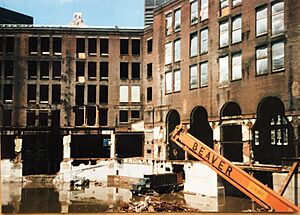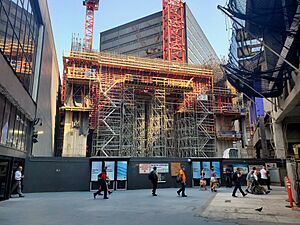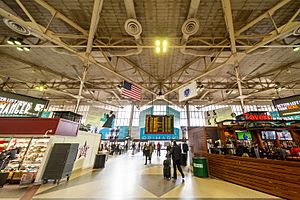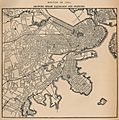South Station facts for kids
Quick facts for kids
South Station
|
||||
|---|---|---|---|---|
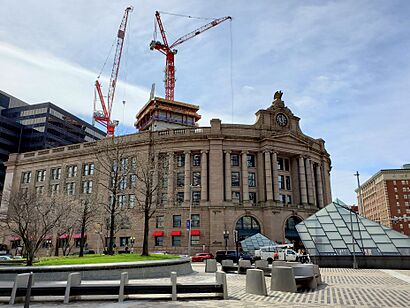
The exterior of South Station, with the under-construction South Station Tower in the background; 2023
|
||||
| Location | 700 Atlantic Avenue Boston, Massachusetts United States |
|||
| Owned by | Massachusetts Department of Transportation | |||
| Line(s) | Attleboro Line (Northeast Corridor) Dorchester Branch Old Colony Mainline |
|||
| Platforms | 6 island platforms, 2 side platforms | |||
| Tracks | 13 | |||
| Connections | ||||
| Construction | ||||
| Bicycle facilities | Bike lockers (Currently closed due to construction) | |||
| Other information | ||||
| Station code | Amtrak: BOS | |||
| IATA code | ZTO | |||
| Fare zone | 1A (MBTA Commuter Rail) | |||
| History | ||||
| Opened | 1899 | |||
| Rebuilt | 1985 | |||
| Traffic | ||||
| Passengers (2018) | 28,416 daily boardings (MBTA Commuter Rail) | |||
| Passengers (FY2019) | 1,585,216 (Amtrak only) | |||
|
||||
|
||||
|
South Station Headhouse
|
||||
| Area | 0.5 acres (0.2 ha) | |||
| Architect | Shepley, Rutan & Coolidge; Norcross Bros. | |||
| Architectural style | Classical Revival | |||
| NRHP reference No. | 75000299 | |||
| Added to NRHP | February 13, 1975 | |||
South Station, officially called The Governor Michael S. Dukakis Transportation Center at South Station, is a huge transportation hub in Boston, Massachusetts. It's the biggest train station and bus terminal in the Greater Boston area. It's also the second-largest transportation center in all of New England, after Logan International Airport.
This historic building, built in 1899, is located where Atlantic Avenue and Summer Street meet in Dewey Square. It was created to bring together several different railroad lines into one main station. Today, it's a busy place where thousands of people catch commuter trains, long-distance trains, and intercity buses every day. You can also connect to Boston's subway system, the Red Line, and the Silver Line bus rapid transit here.
The station was renamed in November 2014 to honor Michael S. Dukakis, a former governor of Massachusetts. However, most maps and signs still use the shorter name, "South Station."
Contents
History of South Station
South Station has a long and interesting history, starting from a time when Boston's railroads were very different.
Why Boston Needed One Big Station
Back in the late 1800s, each railroad company in Boston had its own separate station. This meant that if you wanted to switch from one train line to another, you might have to travel across town to a different building. It was confusing and inconvenient for travelers.
To solve this problem, a company called the Boston Terminal Company was formed in 1897. Their goal was to combine all the different train services from the south side of Boston into one large, central station. This new station would be known as a "union station" because it united several different rail lines.
South Station's Early Days
South Station officially opened its doors on January 1, 1899. It cost about $3.6 million to build, which was a huge amount of money back then! The famous architects Shepley, Rutan and Coolidge designed the building.
By 1913, South Station had become the busiest train station in all of New England. It was a bustling place with many trains and passengers. An elevated train line, called the Atlantic Avenue Elevated, also served the station from 1901 to 1938. Later, in 1913, the subway's Red Line was extended to include a stop at South Station.
The station originally had a massive roof over its train tracks, called a train shed. However, this roof was removed in 1930. The salty air from the nearby ocean caused the metal to rust, making it unsafe. Some tracks that were planned to go under the main platforms were never used. They later became a parking lot and even a bowling alley for employees!
Changes Over the Years
During World War II, South Station was incredibly busy, handling about 125,000 passengers every day. But after the war, fewer people traveled by train. In 1959, some train services to the South Shore and Cape Cod stopped running. The New Haven Railroad, one of the main companies using the station, even went out of business in 1961.
In 1965, the station was sold to the Boston Redevelopment Authority (BRA). Parts of the station were torn down to make way for new buildings. In the early 1970s, there were plans to demolish the rest of South Station and build a completely new complex. However, this plan never happened. Instead, South Station was recognized as an important historical site and added to the National Register of Historic Places in 1975.
Modern Updates and Renovations
In 1978, the BRA sold the remaining parts of the station to the MBTA, which runs Boston's public transportation. Money was found for a major renovation, which finished in 1989. This project added 13 tracks, all with modern, high-level platforms. It also created a direct connection from the main station lobby to the Red Line subway.
A new intercity bus terminal opened in October 1995. This terminal was built right over the train tracks and has direct ramps to major highways. The renovations, including the bus terminal, cost $195 million.
Recently, in September 2017, a company called Ashkenazy Acquisition Corporation bought the lease for the office and concourse areas of the station. As of mid-2025, the MBTA plans to install fare gates for the commuter rail and Amtrak platforms. Also, a big project to upgrade the train tracks and signals outside South Station is underway. This $99 million project is expected to be finished by 2026.
The South Station Tower Project
When the MBTA bought South Station, the city kept the "air rights" above the tracks. This means they could build above the station. The South Station Tower is a huge project being built using these air rights. It will include a 51-story skyscraper, which is about 678 feet tall. It will also expand the bus terminal.
Construction on the tower began in January 2020 and is expected to take four years. The tower is being built on foundations that were put in place during the station's last renovation. This project will also add a new arched roof over the outdoor waiting area, cover the entire platform area, and create a new entrance from Dorchester Avenue. It will also make it easier to get to the bus terminal.
South Station's Architecture
South Station's main building, called the head house, and its wings are built in a style called Neoclassical architecture. This style is known for its balance, straight lines, and use of stone.
Building Design and Materials
The building's design is very symmetrical, meaning both sides are mirror images of each other. It's made of granite stone, which came from quarries nearby in New England. The main entrances are located in a part of the building that sticks out from its curved shape. These doors are under tall arches, which make the building look grand and impressive.
Above the doorways, you'll see classical Ionic order columns. These columns support the decorative parts above them. The many parts that stick out and go back into the building create interesting shadows and light patterns on the stone. Inside, the ceiling has a pattern of sunken panels, called a coffered ceiling, which helps protect travelers from rain and snow.
The Famous Clock and Eagle
The large clock on top of the main building is over 100 years old. It's the biggest working hand-wound clock in New England! The clock looks a bit like London's Big Ben and has a face that is 12 feet wide. The clock's inner workings weigh more than 400 pounds.
In 2008, the clock was carefully taken apart and repaired. New parts had to be made by hand. This clock is a special reminder of older times, helping commuters catch their trains and amazing visitors with its history. An eight-foot-wide stone eagle, weighing over eight tons, sits on top of the clock. This eagle is similar to statues often placed on classical buildings.
How the Building Shapes the Area
The curved shape of South Station's front pushes its presence into the surrounding area. This makes it stand out and creates a welcoming main entrance from Atlantic Avenue, Summer Street, and Dewey Square.
In the 1980s, South Station was in need of repair. A big effort, using government money, helped bring the station back to life. Two new wings were added to each side of the main building, using the same granite to match the original look. The renovation finished in 1989, making the area lively again with a key transportation link. New office buildings started to appear nearby. With the completion of the Big Dig highway project and the creation of the Rose Kennedy Greenway, South Station has become even more important. The Greenway is a park that connects South Station to North Station, making it easy for people to walk between them.
Art at the Station
South Station also features two pieces of public art:
- Destinations (1995) by Jeffrey Schiff is made of 25 cast iron spindles hanging from the ceiling in the entrance area.
- Musclebound for Miami (1991) by Mayer Spivack is a 4,000-pound sculpture. It's made from parts of train car connectors and is located near the information desk.
Services at South Station
South Station is a busy place that offers many ways to travel: by heavy rail (long-distance trains), rapid transit (subway), and bus.
Train and Subway Services
It's the northern end of Amtrak's Northeast Corridor, serving trains like the Acela Express, the Northeast Regional, and the Boston part of the Lake Shore Limited. It's also the main station for nine southern lines of the MBTA Commuter Rail system, which takes people to and from Boston.
Underground, there's a subway station for the Red Line and the Silver Line bus rapid transit. Local MBTA buses (lines 4, 7, and 11) and the Silver Line route SL4 also stop at South Station.
Station Amenities
South Station has many features to make your trip easier:
- A parking garage for cars.
- Ticket windows with staff to help you.
- Baggage assistance available 24 hours a day.
- An information booth that is open all the time.
- A special Metropolitan Lounge with free services for some travelers.
- A food court with places like Dunkin' Donuts, McDonald's, and Starbucks.
- Shops, including a Boston souvenir shop and a CVS Pharmacy.
- Public art, like the sculpture made from train car parts.
- Free Wi-Fi to stay connected.
All the train platforms for commuter rail and Amtrak are fully accessible. This means you can get from the main entrance to the trains without using stairs. Elevators are available to reach the subway station. You can also get to the bus station from the train platform area.
The Bus Terminal
Boston's main intercity bus terminal, the South Station Bus Terminal, is in a separate building. It's built right over the train platforms along Atlantic Avenue. Bus companies like Greyhound and Peter Pan use this terminal. You can catch buses here to all of New England, New York City, Philadelphia, Washington, D.C., and even Montreal, Canada. The bus terminal has its own shops and food places. You can enter it from the train platform area or directly from Atlantic Avenue.
Future Plans for South Station
South Station is a very important transfer point, and more people are expected to use it in the future. While the subway stations are fine for now, the train platforms for commuter rail and Amtrak are already very busy.
Expanding Train Capacity
There's a plan to move the Boston General Mail Facility, which is next to the train tracks. Moving it would allow South Station to add seven more train tracks to the existing thirteen. This would mean more space for both MBTA Commuter Rail and Amtrak trains.
In 2010, the state of Massachusetts received a $32.5 million grant from the government to start planning this expansion. The project would involve tearing down the postal facility and is expected to take about five years to complete once it begins. This expansion would allow for more commuter rail service and new train lines.
The North-South Rail Link Idea
Some transportation experts and community groups believe that expanding South Station isn't the best long-term solution. They suggest building a North–South Rail Link (NSRL) instead. This would be a tunnel connecting South Station to North Station and other points beyond. This way, trains could travel straight through Boston instead of having to turn around at dead-end stations like South Station.
Former governors Michael S. Dukakis and William F. Weld are strong supporters of the North-South Rail Link. They argue it would be more efficient for the entire region. A study in 2018 looked at different tunnel options for the NSRL, with costs ranging from $12.3 billion to $21.5 billion. The South Station expansion project was estimated to cost $4.7 billion in comparison.
Images for kids
See also
- Atlantic Avenue Elevated
- Fort Point Channel
- North Station
- North–South Rail Link
- South Station Bus Terminal
- National Register of Historic Places listings in northern Boston, Massachusetts


